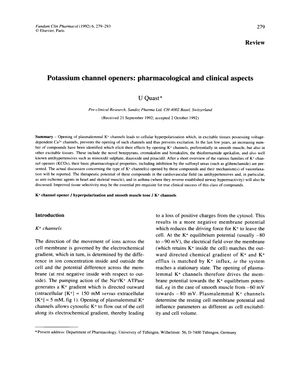Potassium channel openers: pharmacological and clinical aspects
October 1992
in “Fundamental & Clinical Pharmacology”

TLDR Potassium channel openers could help treat cardiovascular diseases and asthma but require better targeting to specific tissues for effective use.
The document from 1992 reviews potassium channel openers (KCOs), which are compounds that induce hyperpolarization in cells by opening potassium channels, affecting smooth muscle and other tissues. It covers various KCOs, including cromakalim and minoxidil sulphate, and their basic pharmacological properties, such as their inhibition by sulfonyl ureas like glibenclamide. The review also discusses the therapeutic potential of KCOs in cardiovascular diseases and asthma, emphasizing the need for improved tissue selectivity for clinical success. It notes that KCOs may work through multiple mechanisms, including inhibiting calcium release from intracellular stores and affecting IP3 production. The document highlights the controversy over the doses needed for different therapeutic effects and the importance of understanding the types of potassium channels targeted by KCOs for their effective application in treatment.
View this study on onlinelibrary.wiley.com →
Cited in this study

research Differential inhibition by tedisamil (KC 8857) and glibenclamide of the responses to cromakalim and minoxidil sulphate in rat isolated aorta
Tedisamil and glibenclamide affect cromakalim and minoxidil sulphate differently in rat aorta.

research The action of diazoxide and minoxidil sulphate on rat blood vessels: a comparison with cromakalim
Diazoxide, minoxidil sulphate, and cromakalim relax rat blood vessels by opening K+ channels, with some differences in their actions.

research Topical minoxidil: cardiac effects in bald man.
Using topical minoxidil for baldness can cause heart problems, especially in those with heart disease.